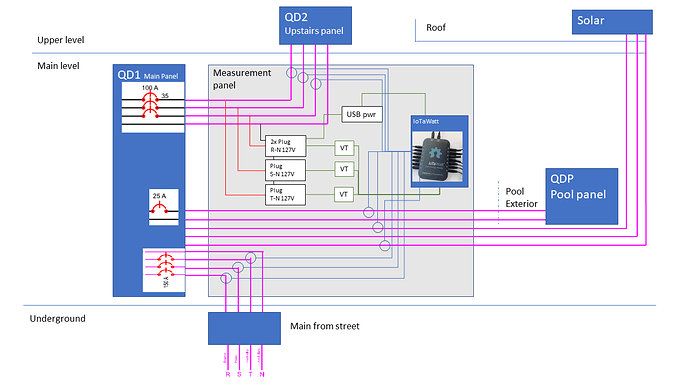Hello folks,
EDIT - The Neutral from the mains were not connected to the panel, causing the voltage to fluctuate. Thankfully I was able to identify before anything was really connected to the panel. Once this issue is corrected, I’ll measure the voltages again and setup the IotaWatt to test it again.
– Original for historical purposes –
I finally have the panel installed in my new place in Brazil, following up from this post.
With the panel in place and the mais connected, I am measuring ~240+v phase-phase (which should be 220v), and 148v neutral-phase (should be 127v). This is roughly the same across all 3 phases, and 3 phases to neutral.
With this setup, the JW-95001-NA VT is giving me a 13.5v measured with a voltmeter. Is this too high of a voltage for the IoTaWatt unit to support?
I’m reaching out to the utility company to check on the voltage, but I suspect I might have to be prepared for this voltage fluctuation to be present in the system (+10% on Phase-phase) unfortunately.
For context, here is the schematic of the system once completed. The solar system is single-phase, but connected at 220v phase-phase on the R,S,T phases as R-S, T-S.
Thanks
The maximum half-wave peak voltage is 1.6V. That would be 1.1313V RMS. The IoTaWatt uses a 1K-12K voltage divider on the VT input so x13 is 14.70 RMS max at the VT input. The calibration for JW-95001-NA VT is 11.14 so the theoretical maximum plug voltage per the IoTaWatt would be 163.7 V.
I have no idea what would happen to that VT if you plug it into 163V or even what is happening at 148V. It is certified for 120V. Hopefully the neutral line will have reined in the phase-neutral voltage.
I measured the phase-neutral at the entrance, and it’s 127V as intended, so we should be good once connected.
I’ll measure it all again once it’s correctly connected. Unfortunately the professionals who made the connection missed it. Glad it was before any internal connection was made.
Just a heads up, I am not an electrician!
Safety detail…
In our old house we have a sub-panel and we are to keep neutral not-grounded here. Grounded in the main panel is OK (or good, or absolutely necessary, I don’t know which).
As I was about to make the correction (disconnect neutral from ground in sub-panel) I first took some current measurements. There was significant current between house and main panel travelling on the ground conductor, rather than on the neutral, when our split-phase consumption was unbalanced. The ground cable in the conduit is not sized for this, that’s what the neutral is for!
Just want to mention this in case there’s more to this picture for some other people. If you find neutral disconnected from ground there COULD be a very good reason for that. An electrician needs to make the decision about neutral / ground connection.
edit: I mis-read the “Edit” above… neutral from mains was missing?? yikes. Good catch.
Yup, the Neutral was not connected. Yikes indeed, good thing it was caught before anything was ever connected to power (aside from this one plug for IoTawatt).
I finally have solar installed and generating, so will setup everything and post an update once I got it.
1 Like
